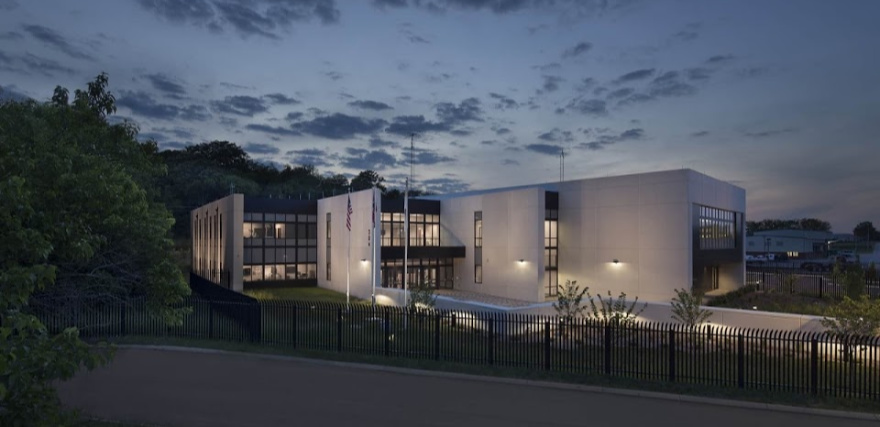The Williamson County Public Safety Center in Tennessee went live in 2016.
The 56,200-square-foot physical plant of the center, its equipment and its technology stack up to the sturdiest and most state of the art centers in the US.
Here are a few examples:
The building is structurally built to withstand F-5 tornado conditions, has enhanced seismic and ballistic protection and meets FEMA 361 standards. It has N+2 redundancy, three generators and two separate electrical feeds from different relay stations. The center has N+1 fiber connectivity, with a connection at the main fiber loop and another fiber connection from a separate location.
The only location at the facility that differs from the durabiliy standards is the garage, because no manufacturer makes garage doors that meet the same standards as the rest of the building. That’s where equipment such as this 100-foot communications tower, which has been used for disasters around the southeast US, is kept.
Photo: Paula Kiger
From this resilient facility, five law enforcement departments, nine fire departments and two emergency medical departments are supported by 54 frontline personnel and four administrative staff. Dispatchers take 60,000 9-1-1 calls annually and 168,000 nonemergency calls.
The most important factor behind the WCPSC’s success has nothing to do with the building, the equipment or the technology.
In a panel presentation, representatives of several stakeholders explained the way local government came together to implement the center’s “one community, one mission, one program” goal.
Patience with the process
County Mayor Rogers Anderson said planning for the WCPSC started in 2000, when people from 45 different disciplines were assembled and told to dream about what would be ideal without worrying about cost.
A groundbreaking took place for the 53,000-square-foot facility in 2014, prior to the April 2016 opening.
It took 16 years of perseverance to bring this center to life.
Writing for StateScoop, Kjeld Lindsted, who served in the smart city program in Redlands, Calif., says one of the biggest lessons he learned working for local government was “be patient.”
Focus on what matters
Between those initial visioning sessions and the opening of the facility in 2016, Brentwood, Tenn., City Manager Kirk Bednar says an emphasis on building trust by starting at the operational level (rather than the political) was key. Department heads, fire chiefs, police chiefs and other emergency personnel worked and trained together. Doing so, says Bednar, “started building that foundation of cooperation among the municipalities and the county.”
A public safety committee comprised of operational staff expanded to fold in the city managers, city administrators and county mayor. Starting at the operational level gave those individuals some demonstrable evidence of the benefits of working together, says Bednar..
The organizers focused on areas that were identifiable to all stakeholders: public safety and schools.
Shared purpose and political trust matter
Michael Fletcher, director of safety and security for Williamson County Schools, discussed the relationship between the schools, where around 55,000 of the county’s 240,000 residents are every day. In discussing how the center helps schools create their disaster plans, he explained how teamwork grows. “Every time you come to the table, ask ‘what can we offer each other?’” he says.
Elaborating on the foundation of shared purpose and political trust, Bednar said the more dialogue there is, the more opportunities to use resources wisely appear. He also stressed the fact that every entity pays its fair share.
Always plan ahead
The WCPSC set out to meet the county mayor’s goal of “wearing the hinges out.” As they look forward, these are the national trends they are following.
- FirstNet deployment (development of priority wireless voice and data for public safety)
- National deployment of text-to-9-1-1, which will deliver SMS and MMS information direct to call controllers
- Mitigation of cybersecurity concerns around protecting public safety networks
- Ensuring 9-1-1 funds collected go to supporting 9-1-1 operations and technology and ensuring the existing rate is sufficient for supporting 9-1-1 operations and technology
- Reclassification of telecommunicators from “office and administrative support” occupations to “protective service” occupations within the Office of Management and Budget, which would give telecommunicators access to better training and benefits
Don’t fall in love with Plan A
The center is designed to encourage communication among staff. There are small areas set up throughout the facility to facilitate one-on-one communication, including whiteboards throughout. One small table tent seemed to sum up the center’s approach. It read “don’t fall in love with Plan A.”
This county seems to have set for itself plans B and C too. Evidence to date says they’ll probably find and implement the right plan, as long as they are patient, focus on the right things and cooperate with each other as they have so far.
Thank you to the Williamson County Public Safety Center for some of the information shared in this post.
____________________________
The free National Emergency Number Association Public Safety SmartBrief, as well as the ICMA SmartBrief, two of more than 200 industry-focused newsletters, provide information relevant to local government professionals interested in public safety. Please visit each link to subscribe.
Paula Kiger edits SmartBrief’s nonprofit sector newsletters, including the NENA and ICMA SmartBriefs, and co-manages @SBLeaders on Twitter. She worked extensively in Florida’s quasi-governmental children’s health insurance program that became a national model, has served as a United Nations Foundation Shot at Life Champion leader, has proofread professionally and has extensive social media experience. You can find her at her blog Big Green Pen, on Instagram, at LinkedIn and on Twitter.
